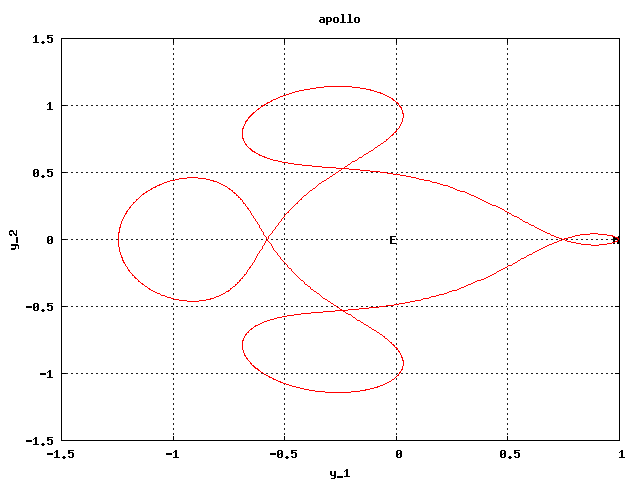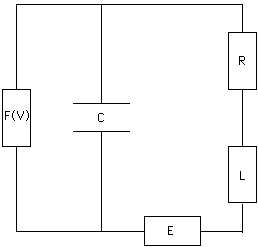
Initial value problems: predefined cases
- onedimensional model equation y'(t) = -2y(t)
with initial value y(0) = 1. Analytical solution is
y(t) = e-2t. Endpoint of integration is b =
1. This is an easy case, where even Euler will perform well.
- onedimensional case with a moving singularity y'(t) =
y2 with initial value y(0) = 0.25. Solution is
y(t) = 1/(4-t). Here b is chosen shortly before the singularity: b= 3.95
at t = 4.
Hence you should observe near b a strong reduction of the stepsize and a sharp growth of
the global error.
- The restricted three body problem (has a common plane)
(earth - moon - Apollo module). written as a first order system it has 4
components which read
- F1(t,y) = y2.
- F2(t,y) = y1 + 2y4(t) -ν (y1 + μ) / SQRT[ ((y1 + μ)2 + y32)3 ] - μ (y1 - ν) / SQRT[ ((y1 - ν)2 +y32)3 ].
- F3(t,y) = y4.
- F4(t,y) = y3 - 2 y2 - ν y3 / SQRT[ ((y1 + μ)2 + y32)3 ] - μ y3 / SQRT[ ((y1 - ν)2 +y32)3 ].

- The nonlinear RLC circuit with a tunnel diode in parallel position
receives voltage from an external source which is taken from a periodic jump function,
(+/-0.022). The current in this circuit is periodic in the limit.
The system is very stiff and the solution oscillates in [0,1] very strongly.
Initial time is a = 0 and endtime b = 16.
Problems occur, if the stepsize has the order of magnitude of the period of the external source.

The data of this circuit are L = 0.01, C = 0.01 , E = E0 + S(t)DE, DE=0.022 , S(t) = +/- 1 , R=0.017 F(V)= 6650*V*(V**2- 3*(0.148*V - 0.0167) ) - The reduced Reynolds equation describes in a quite simplified form
the motion of a metallic ring pressed down in a viscous fluid towards a fixed plate
with force
p(t). This equation is strongly nonlinear and extremely stiff.
- F1(t,y) = -(c1*c3*c4*c5**3/c2)*y1/(y23) -p(t)/c2,
- F1(t,y) = y1 .
- A scalar equation with discontinuous right hand side (jump discontinuity of F, with a kink in the true solution).
F(y,t) = y(t)2, if 0<= t <= 1/sqrt(2) and
F(y,t) = 2(y(t)-y(1/sqrt(2))-1), if t > 1/sqrt(2).Initial value is y(0) = 1
and integration ends at b = 3. You should observe a sharp reduction in the stepsize at t=0.707... and a strong jump in the local discretization error, which in turn yields an unrecoverable growth in the global error.